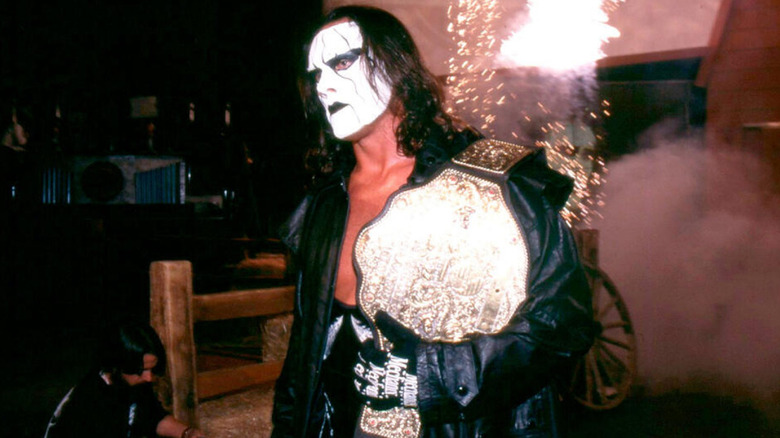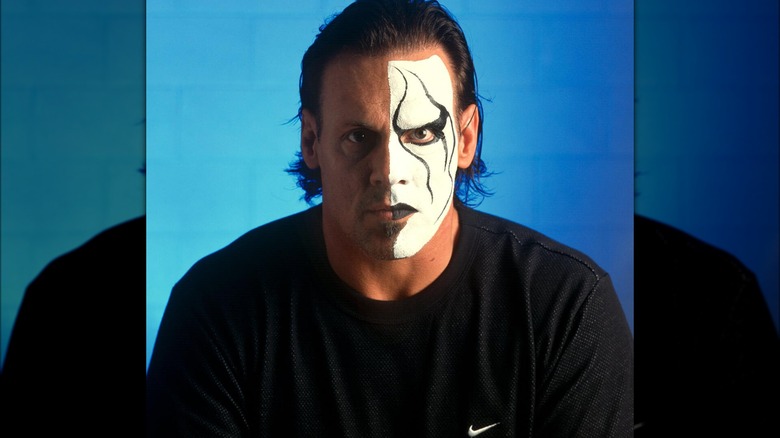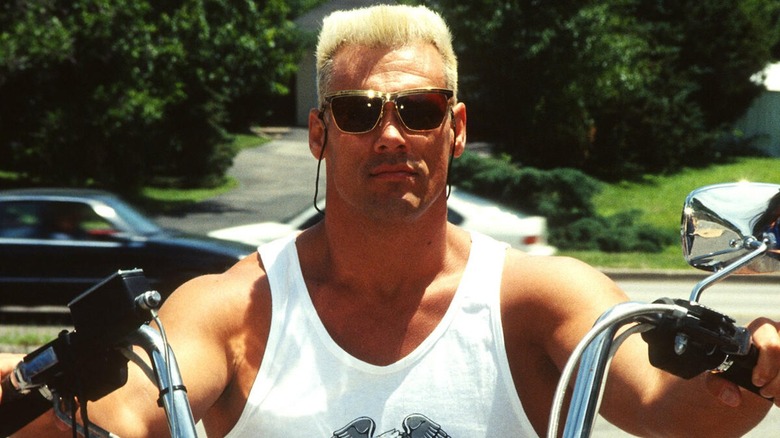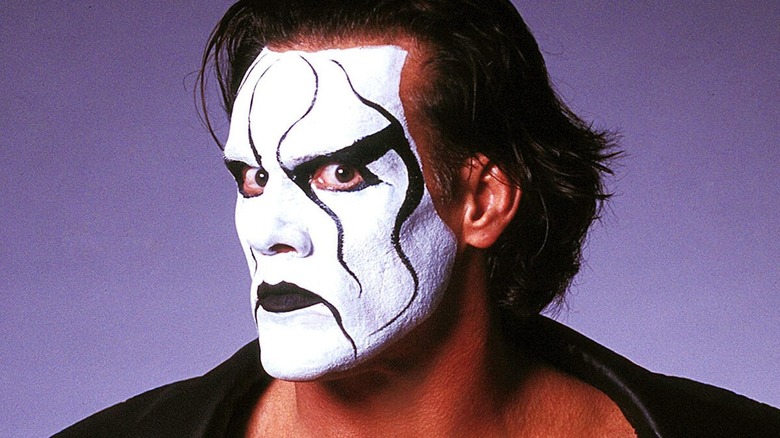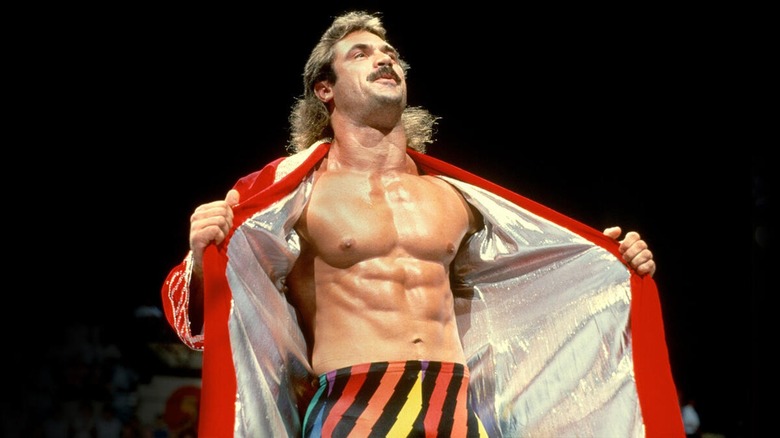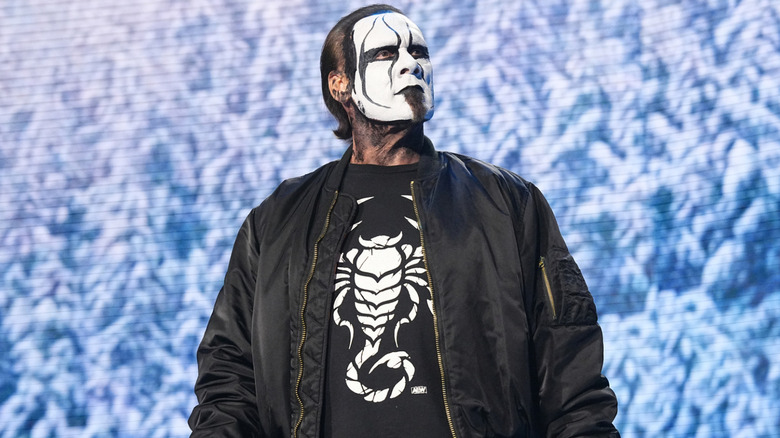The Tragic Side Of Wrestling Legend Sting's Real Life
Sting has enjoyed a decorated career in pro wrestling, and holds the distinction of being one of the oldest active wrestlers in the industry today. Due to this, "The Icon"s career has spanned an insane 39 years, six World Championships between WCW and TNA, and many more titles, with his latest being the AEW World Tag Team Championship. When he broke into the industry, Sting teamed up with the late Ultimate Warrior as "Power Team USA" before being repackaged as "The Blade Runners." Both men later parted ways, but continued to incorporate face paint in their gimmicks. Sting ultimately made his way to NWA, where he became the "Surfer Sting" version of his character, and established himself as a major singles star with his high-profile feud with Ric Flair.
In 1996, Sting would transform into his "The Crow"-inspired gimmick as the NWO invaded WCW. During this run, he'd become "The Vigilante," and stick with the ill-fated promotion until its closure in 2001, historically taking part in the final WCW match against Flair. Following a brief hiatus and world tour, Sting would sign with TNA, where he'd further develop his character and become one of the biggest names in the promotion.
In 2014, Sting finally jumped to WWE, but despite initial praise, his run with the company is often criticized to this day. Finally, Sting shocked the industry by debuting in AEW during the inaugural "Winter is Coming" episode of "AEW Dynamite" in 2020. Sting quickly aligned himself with Darby Allin, and soon the two men will compete alongside each other more time at Revolution 2024, where "The Icon" will retire.
Sting's battle with addiction cost him his family
Unfortunately, like many of his peers at the time, Sting was ultimately consumed by the lifestyle of a pro wrestler in the 1990s, and even with all the success he had as "The Franchise" of WCW and what was arguably the height of his career, he wasn't a happy man. In an article written for "The Players' Tribune" in 2022, Sting — now 64 — recalled just how badly his addictions had taken over his life.
"I was spiritually empty. I was an addict. The only time I was sober was when I was doing my job. The other 20-some hours of the day, it was a steady diet of painkillers, muscle relaxers, and booze. It was only a matter of time before I was dead." Sting went on to explain how easily it was to access muscle relaxers at the time, how he'd use them to either pass out during plane rides or just to have a good time and that he used alcohol to sleep. In a 2018 appearance on "Chasing Glory with Lilian Garcia," Sting recalled confessing both his substance abuse and infidelities to his wife at the time.
"I confessed everything to my ex-wife. It was horrendous, it was one of the worst moments of my life watching her lifeblood just come out of her almost, it was just horrendous." Following this, in August 1998, "The Icon" found religion and gave his life to Jesus Christ. "I was at the very peak of my career. Muscle relaxers, pain relievers, alcohol, women, a lifestyle, even language that comes out of my mouth, everything changed radically overnight, and I was watching friends die from this kind of lifestyle over the years."
Sting's battle with substances began way before his Iconic run in WCW
While opioids took over his life in the mid to late '90s, Sting was no stranger to substance abuse. Before his foray into wrestling, "The Icon" was a bodybuilder. and had a steroid habit that he carried into his wrestling career. In an interview with "Muscle and Fitness," Sting recalled how heavy his training regimen was and admitted to his steroid usage. "I never did the powerlifting thing, but the goal was to lift heavy. On the bench, my best was 435 — I was younger and I was on the gas, too. I didn't really train for power or strength. I trained for size."
Following this, he admitted his knees are arthritic after years of heavy training, but recalled totally stopping his steroid use in 1990. "Thankfully, I got smart somehow or another in 1990 and stopped taking steroids — totally stopped. A lot of the guys I ran with all those years continued to take steroids year after year — those guys are having their knees and their hips replaced."
Sting noted how kicking the steroids likely extended his career, but expressed how he would have approached training differently if his career started today. "I'm not saying everybody who gets their knees and their hips replaced took steroids. I just noticed that the guys who did that were too big, too bulky, too heavy, and the body couldn't handle it and it took its toll. So that was my one saving grace, but I would train differently now."
Sting's iconic entrance from the rafters could've cost him his life
When Sting drastically changed his gimmick to the white facepaint "Crow" character, he began descending from the arena rafters, often surprising his opponents. "The Icon" recreated this entrance during a recent "AEW Dynamite," where he took out The Young Bucks and saved Ric Flair and Darby Allin. Over the years, this unique arrival has added to his mystique, however, it nearly cost him his life. In a 2004 interview with "Wrestling Epicenter," he admitted the entrance always scared him. "You know, it was scary. And we did it a couple of different ways, and it didn't matter which way we did it; it was always scary."
Sting recalled how they practiced the entrance multiple times before he debuted it at the United Center, that the rafters were 140 feet above the ring, and that they had to use walkie-talkies to communicate with the crew on the ground floor. Surprisingly, he also claimed he nearly backed out of the entrance, worrying that he'd botch it and ruin his career.
Sting then recalled Owen Hart's tragic death and how he nearly suffered the same thing, as he and the rafter crew luckily realized that things were set up incorrectly. "When I stepped over, we realized we had the thing set up backward — so while I was standing on the edge, we had to flip the rope around and then reweave it through ... I'm telling you if I'd stepped over and done it, the same thing that happened to Owen would have happened to me." (per Pro Wrestling Stories).
Sting is partly responsible for Rick Rude being forced to retire
"Ravishing" Rick Rude was involved in many major feuds across his career in both WWE and WCW, and is fondly recalled for his memorable gimmick, where he'd insult the "sweathogs" in the crowd and take his robe off to display his sculpted physique. Much like many stars in the '90s, Rude left WWE behind and made his way to WCW.
Rude was seemingly positioned for a main event spot in early '90s WCW, quickly challenging Sting and even defeating Ric Flair for the famous "Big Gold Belt" not far into his tenure with the company. He then entered into another feud with "The Stinger," and the two went on to have a match in Japan. Unfortunately for Rude, Sting hit him with a Suicide Dive that resulted in Rude severely injuring his back. While he won the match, this would be Rude's final wrestling match, and he'd be forced to retire thereafter. This naturally led to heat between the two following the situation.
Despite his injury, Rude still remained an onscreen figure for some time, even returning to WWE and appearing for ECW. He'd go on to be one of the inaugural members of the D-Generation X faction. Rude also holds the distinction of being the only person to appear on both an episode of "WWE Raw" and "WCW Nitro" on the same night. He was training for a return to in-ring competition in 1999, but sadly suddenly passed away at the age of 40 in what's been described as a "mixed meditation overdose." Interestingly, the late Road Warrior Animal opined that Rude's death was not an accident but instead a suicide, and in a 2017 interview, he gave his take on why he thought this was the case.
Competing in his 60's has likely caused serious damage to Sting's body
"The Icon" has shocked the industry by continuing to compete at 64 on a level that many of the men 20 years his junior can't anymore. He's notably gone above and beyond, by not just holding his own in the ring, but putting his body on the line performing death-defying stunts. Sadly, Sting might just have pushed himself too far. According to Sting himself during 2022's AEW Revolution media scrum, his body takes a lot longer to recover these days and he has changed his training accordingly. "I have to train and do everything completely different than I did. And it takes me a lot longer to recover after these matches." (Per "Essentially Sports").
Sting hasn't slowed down at all since, and has performed even bigger stunts with every pay-per-view. Naturally, he will probably put his body on the line one last time this weekend in his final match, and perform a stunt that will rival anything else he's done in AEW. Sting has commented on the state of his body recently as well, but explained that he simply chalks his long career up to "potluck."
The veteran has noted in the past that his original plan wasn't to retire in 2024, meaning he could have been forced to hang up his boots this year. So, while his body will likely feel the effect of the last four years in due time, it seems that he felt he could go on for an undisclosed number of matches.
